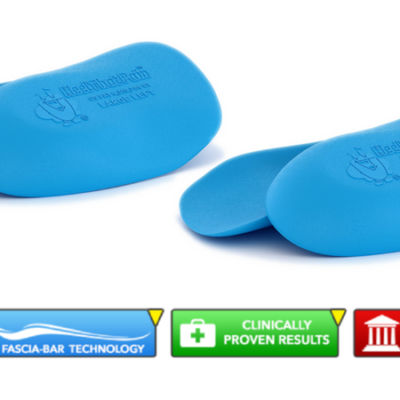Plantar Fasciitis Shoes
Finding the Best Fit For Your Health AND Your Budget
If you’ve been diagnosed with Plantar Fasciitis, you’re probably seeing your shoe closet in a whole new light. Do you need to toss your favorite pair of flats in favor of orthopedic clogs? How do orthotic inserts stack up to orthotic shoes? Will any of your “normal” shoes offer the support you need to recover from heel pain, heel spurs, or Plantar Fasciitis?
We have your answers!
Orthotic Shoes Vs. Orthotic Inserts
Orthotic inserts and orthotic shoes can help with heel pain by giving your arch much needed support and cushioning while it heals. Each type of support comes with its own pros and cons:
Orthotic Shoes for Plantar Fasciitis
Orthotic shoes are often seen as the go-to option for Plantar Fasciitis. And for good reason! A good pair of orthotic shoes can significantly improve heel pain and Plantar Fasciitis. Here’s what you need to know:
Pros
Many Options: In the not-so-distant past, orthotic shoes came in very limited styles. However, there are now a variety of brands and styles to choose from, including work shoes!
Read-to-Wear Convenience: If you’re the “capsule wardrobe” type, with one or two pairs of go-to shoes, orthotic shoes offer ready-to-wear convenience
Effective: The right pair of orthotic shoes can be very effective at easing heel pain and treating Plantar Fasciitis. Look for orthotic shoes that offer not just cushioning but arch support and targeted realignment of the fascia.
Cons
Expensive: If you’re on a shoestring budget (pun intended!) the price tag on orthotic shoes may come as an unpleasant surprise. While some shoes with advanced arch support start in the $75 range, specialty shoes for Plantar Fasciitis regularly run in the hundreds of dollars.
Style Restrictions: While it’s true that orthotic shoes come in a variety of styles, you aren’t going to find nearly as many current trends or color options. If shoes are your favorite wardrobe staple, orthotic shoes may not be your best option.
Varied Results: The quality and effectiveness of orthotic shoes vary significantly from brand to brand, and shoe to shoe. Read plenty of reviews before you make a purchase, and look for a shoe that’s specifically designed to realign the arch and foot, not just cushion the heel. Many shoes can offer pain relief through cushioning–but only a few address the underlying cause of heel pain.
Orthotic Inserts for Plantar Fasciitis
What do you imagine when you hear the words “orthotic inserts.” A flimsy piece of foam you can snag at any grocery store? Not so fast.
While there are a huge variety of insert styles (and quality levels) available, the best Plantar Fasciitis inserts go toe-to-toe with the best Plantar Fasciitis shoes–and even offer a few unique advantages. Here’s what you should know:
Pros
Inexpensive: You can get a pair of high-quality, clinically proven insoles for the cost of a few cups of coffee (Between $24.95-$34.95)! If you’re trying to keep your expenses down, orthotic inserts can be a major budget-saver.
Effective: Heel Seats, the leading insert for treating Plantar Fasciitis, have a success rate of 90% in clinical trials. These unique inserts use Fascia Bar Technology to realign the arch and provide targeted acupressure, along with soothing cushioning.
Versatile: If you love shoes, orthotic inserts are a fantastic option. Inserts can be swapped in and out of all your favorite pairs of shoes, allowing you to maintain your unique sense of style.
Durable: While cheap foam inserts wear out quickly, high-quality inserts are 100% washable and can last as long as a pair of orthotic shoes.
Cons
Overwhelming Options: Unlike orthotic shoes, you might find yourself overwhelmed by all the options for orthotic inserts. But remember, just like orthotic shoes, not all orthotic inserts are created equal. Choose inserts that target the cause of your heel pain with solid arch support, ample cushioning, and targeted acupressure.
Varying Quality: Flimsy foam inserts that can be crushed by the weight of your hand aren’t going to stand up to the rigors of walking, running, and jumping–even if they do cost $5! Choose durable, high-quality materials and a product that’s backed by glowing user reviews.
Can I Still Wear Normal Shoes?
The answer to this question is, of course, YES! A good pair of orthotic inserts are just as effective as a good pair of orthotic shoes–with the added benefit of allowing you to continue wearing your favorite pair of shoes.
That said, you should ban some shoes from your closet. Toss any shoes that have become excessively worn in the insole or on the heel, since old worn shoes can alter your gait and increase the risk and pain of Plantar Fasciitis. You’ll also want to sideline shoes with high heels or narrow toes that can put too much pressure on your damaged arch.
Can I Still Wear Sandals with Plantar Fasciitis?
There are two main ways to enjoy sandals this summer, even if you’re struggling with heel pain. The first is to shop for sandals with built-in orthotic support. Most orthotic sandals run between $90-$150, but we’ve priced our own Heel Seat Sandals so that more people can enjoy them!
Many people are also surprised to learn that they can keep their open-toed shoes and summer sandals as well! With a subtle Heel Seat Wrap, you can get the support and healing you need while your toes enjoy the sunshine.
Whether you opt for orthotic inserts, orthotic shoes, Heel Seat Wraps, or a combination of all three, it’s more than possible to find healing and pain relief that agrees with your sense of style–and your budget.






